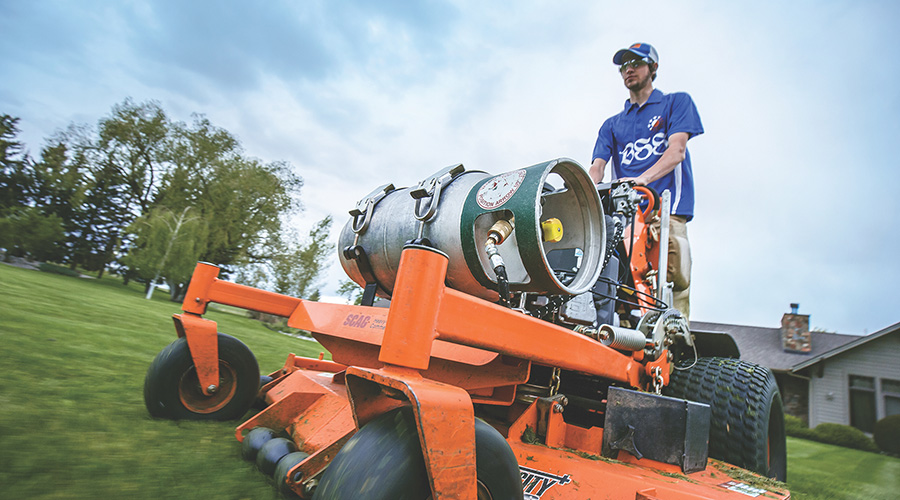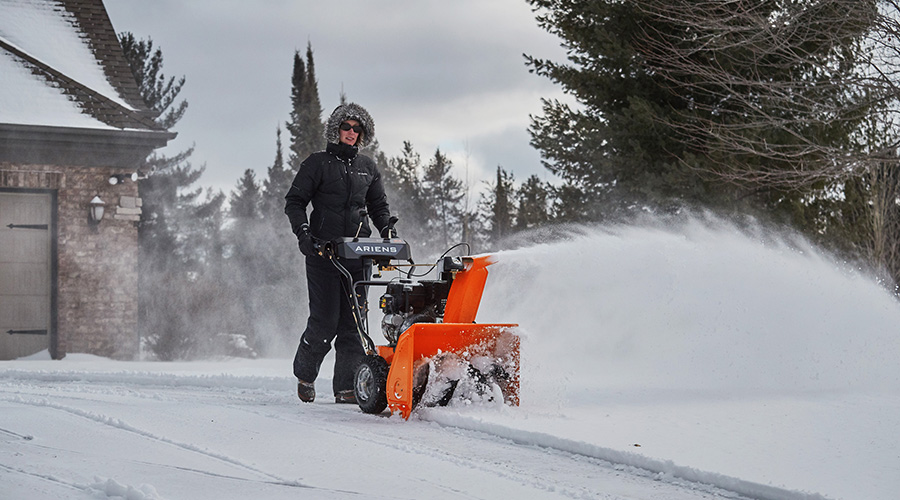Cold-Weather Challenge, Hot-Button Issues
Efficient snow and ice removal requires early, smart decisions on equipment, chemicals and contractors
Removing snow and ice from paved areas around institutional and commercial buildings during winter months can be among the most difficult and stressful work grounds managers will oversee. The challenges of this work include managing crews, preparing for large storms with significant snow and ice, dealing with equipment operator fatigue from long hours, and preventing hazardous conditions for both occupants and visitors.
Beyond these issues, managers will have to stay within or below budgeted constraints. Even with budget considerations, managers must examine snow and ice management with one overall goal in mind: maintaining a safe environment for pedestrians and vehicles, allowing people to go about their daily lives and limiting risk for the organization.
Among the important steps in this process are determining the scope of the challenge, working with crews to understand proper equipment use, and deciding on the role of chemicals.
The Scope of the Challenge
A large winter storm bringing significant snow or ice will result in long hours, fatigue, equipment breakdowns, and potentially hazardous situations for the grounds staff who operate the equipment. Add to that challenge the desired level of service that most building occupants are accustomed to, and that challenge becomes removing snow and ice in the most efficient and cleanly method possible to meet defined goals.
Matching equipment to the workload is critical. First and foremost, managers must always be prepared for equipment failure. There is nothing worse than being stuck in the middle of a large storm and losing one or more of the plows needed to get the job done because, very likely, facility operations will find a way to go on.
Students at a university won’t stop going to class — at least not for snow — a hospital won’t close down, and the businesses in an office building won’t be okay with starting work late because they can’t get in the parking lot.
Equipment Matters
Plows are the most common pieces of equipment, but a snow-removal arsenal also can include pick-up trucks, skid steers and compact equipment, all-terrain vehicles, and front-end loaders and large equipment.
Snowplow manufacturers have made significant advances in construction and design of plows to meet user demands, but the final test is how the operator uses the equipment.
When using a straight plow, the driver should angle the blade away from the building on the first pass. Subsequent passes should be made away from the building and toward the outer perimeter. The general rule is to angle the blade away from a building. The goal is to get the snow as far away from the buildings as possible.
When using V-plows, the driver needs to use a V-position to make an initial breakthrough. This position also is effective for hard-packed snow, ice and deep drifts. The blade should be in the straight position or angled position for general, wide-path plowing or stacking. The scoop position is ideal for clean-up and carrying snow with minimum spilling.
Pushers and Box Plows
A snow pusher on a loader, backhoe, skid steer or compact utility tractor can quickly and efficiently move large volumes of snow. Pushers contain the snow and help minimize windrows, which eliminates the need for repeated plowing of the same area to clean up spills.
When using a snow pusher, the driver must be sure it is attached according to the manufacturer’s specifications. These specifications are designed to provide the best performance, wear tolerance and safety.
By using a loader’s lifting capabilities, drivers can use snow pushers to stack huge piles of snow. And by removing the snow pusher attachment, the driver can operate the unit to loading trucks in case snow must be hauled away.
Deicing and Anti-icing
Historically, departments have removed snow and ice with overuse of chemicals as a complement to the use of shovels, plows, and related equipment. In recent years, granular materials have become a popular and effective method for maintaining safe conditions during and after a storm.
Understanding the difference between anti-icing and deicing can give managers insights into the different approaches that can help them deal with ice efficiently.
Deicing is the reactive application of ice-control products to melt existing snow and ice on driving or walking surfaces. Deicing after snow removal operations can melt any remaining snow and ice.
Anti-icing refers to the proactive application of ice- and snow-melting products to driving or walking surfaces before a storm. This tactic helps prevent snow and ice from bonding to the pavement, and workers can clear them away more easily. Used effectively, anti-icing can create some of the safest conditions in the winter and can be a cost-effective alternative to deicing.
In general, materials used in these two processes include:
Sand. Although sand can provide some traction, it technically is not a deicing material, since sand in no way melts snow or ice. A common misperception is that sand is the best alternative for snow and ice control, due to its low cost and common use. Managers also need to consider the potential environmental impact of sand related to.
Salt. Sodium chloride, or rock salt, is the most common deicer in use today. This product generally is effective, though not at all conditions. In very cold conditions — typically below 23 degrees — salt begins to lose its effectiveness and either is not used or is overused in trying to make up for reduced performance.
Sand-salt mix. Another common practice is to mix sand and salt for deicing. This method is effective in maintaining some traction, due to the sand. But it reduces the amount of salt workers can apply to an area. As a result, less deicing occurs, while the environmental concerns and clean-up costs associated with sand rise.
Managers also have other chemical options for deicing and anti-icing, and each offers differing levels of effectiveness, cost, availability, and environmental impact.
These products include calcium chloride, magnesium chloride, potassium chloride, urea, calcium magnesium acetate, and potassium acetate.
In-house snow removal specialists or private contractors can help managers determine which product might meet a department’s needs.
Planning for winter storms well in advance, including a review of equipment and chemical use, is an essential step for managers looking to avoid the problems snow and ice can bring.
Brian Birch is assistant executive director of the Snow and Ice Management Association, www.sima.org or (814) 835-3577.
Snow Removal: In-house or Outsource?
Managers often wrestle with the question of whether to handle snow and ice removal with in-house staff or hire a contractor. The answer often comes after a review of the benefits and drawbacks that each strategy presents.
The In-House Option
Among the pros:
• More control over crews and the timing of removal
• Possible cost savings, but only if crews are properly trained
• No outsourcing of risk to a third party
• No contracts to sign with a third
• No bidding procedures.
Among the cons:
• Proper equipment required, especially back-up equipment in case of equipment failure
• Advance purchasing of deicing or anti-icing materials for at least portions of the season, ensuring workers do not run out mid-storm
• Implementation, because managers must coordinate crews and comply with applicable laws
• Training, because employers are responsible for proper training and planning
• Potential of property damage that the organization must repair
• Monitoring the weather and determining the preparation needed for staff and equipment
• Added risk if safe conditions are not provided for occupants and visitors.
The Outsourcing Option
The pros include:
• A manager is hiring a specialist to do the work and doesn’t need to be the expert. Among the questions to ask: Is the contractor a certified snow professional?
• Long-term savings for an organization if a manager can form a strong relationship with a solid, dependable contractor. Locking in a good contractor for a two- or three-year contract with defined costs will make budgeting much easier.
• Risk management. By hiring a contractor and signing a contract that defines the relationship with the contractor, managers can outline specific guidelines on who is responsible for various duties.
The cons include:
• Loss of some control
• Time-consuming hiring and bidding process
• High costs, depending on such factors as pricing structures and the amount of winter weather.
Before deciding to outsource all or portions of a department’s snow-removal operations, managers should require a formal bid, a defined contract agreeable to and amended by both the organization and the contractor, and proof of all insurances, including general liability insurance.
— Brian Birch
|
Related Topics:











